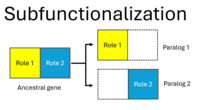Subfunctionalization

So you know how sometimes people have jobs and they have to do lots of different things, like maybe they work at a store and they have to clean the floors, help customers find things, and ring up their purchases? Well, sometimes in our bodies, different genes also have jobs to do, like making proteins that help us see or digest food.
Now, what if there's a gene that used to do two of these jobs, but then something happens and it sort of splits into two genes that each only do one of the jobs? That's what we call subfunctionalization! It's kind of like if the person who used to clean the floors and ring up purchases at the store suddenly became two different people, one who only cleaned and one who only rang up things.
Now, this might seem like it's not as good as the old way, because there's more genes doing the same amount of work, but actually it can be really helpful. For example, if the original gene was really important for both jobs and something went wrong with it, we would lose two important things at once. But if the gene splits into two, we might only lose one of the jobs and still be able to do the other one, because it's now being done by a different gene. So subfunctionalization can actually make our bodies more resilient and better able to handle different situations.
Now, what if there's a gene that used to do two of these jobs, but then something happens and it sort of splits into two genes that each only do one of the jobs? That's what we call subfunctionalization! It's kind of like if the person who used to clean the floors and ring up purchases at the store suddenly became two different people, one who only cleaned and one who only rang up things.
Now, this might seem like it's not as good as the old way, because there's more genes doing the same amount of work, but actually it can be really helpful. For example, if the original gene was really important for both jobs and something went wrong with it, we would lose two important things at once. But if the gene splits into two, we might only lose one of the jobs and still be able to do the other one, because it's now being done by a different gene. So subfunctionalization can actually make our bodies more resilient and better able to handle different situations.
Related topics others have asked about:
